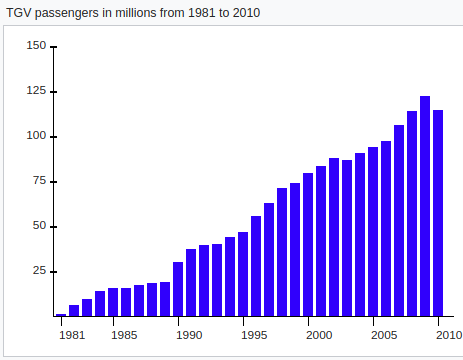Note: GJEL Accident Attorneys regularly sponsors coverage on Streetsblog San Francisco and Streetsblog California. Unless noted in the story, GJEL Accident Attorneys is not consulted for the content or editorial direction of the sponsored content.
In 1983, I flew from New York to France to start an exchange program for junior high-schoolers in Belleville-sur-Saône, a village outside of Lyon, about 300 miles south of Paris. After our grueling overnight flight, my group of ten students from Long Island arrived at one of the main train stations in Paris for the trip to Lyon.
I've been thinking a lot about that experience lately, and my first experience with High-speed Rail, in light of the latest attacks on California's HSR project. Just in, the Trump Administration is trying to withdraw federal funding for the project:
California is 100% committed to a #HighSpeedRail network from Sacramento to San Diego. The President is lying about what Governor Newsom said & what our progress has been. We will fight this illegal action with everything we have. This is about California’s future. https://t.co/83dluXAk1T
— Senator Scott Wiener (@Scott_Wiener) February 20, 2019
I grew up riding the Long Island Railroad, New York subways, and Amtrak to Washington D.C. I'd read of this new train called the Train à Grande Vitesse (TGV), French for high-speed train, which, at the time, was by far the fastest train in the world.
When my class arrived in Paris on that exchange, there were two trains to Lyon on the departure board. One left in five minutes, the other in 30. The later one was a TGV.
"Mr. Bartol," I asked sleepily of our teacher from Long Island. "Why don't we wait 30 minutes and take the one marked TGV?"
"Why? There's a train in five minutes. We can make it."
"We'll get there faster if we wait and take the TGV."
I still remember him chuckling. "Roger, how can a train that leaves later get us there faster!"
We spent the next five or six hours on a hot, uncomfortable train with no food except for some candy bars. We got to Belleville sometime after dark.
Now I feel as if I'm waking up every day to a new Mr. Bartol moment of people in charge not understanding the most basic things about high-speed rail, except this time with far greater repercussions. There was last week's vomitus of false reports that Governor Newsom was killing the project, which lead directly to the Trump Administration's move to pull funding. Shortly before that, the Mercury News published a story from the so-called Reason Foundation which argued, simultaneously, that nobody will ride high-speed trains, but they'll pull people from electric cars.
Sunday morning Rep. Mark DeSaulnier's, who simultaneously votes against all possible funding streams for HSR and then complains that it has no funding, published an op-ed which argued that "California high-speed rail was a vision--but without honest project management. Compare that with the Golden Gate Bridge, whose vision was supported by project management that resulted in the on-time, under-budget, fully funded icon we laud today."
The Golden Gate bridge was completed in 1937, more than 30 years before the passage of the California Environmental Quality Act (CEQA) or the Occupational Safety and Health Administration existed. How about comparing the HSR project to something contemporary, such as the Eastern Span of the Bay Bridge, which came in 26 times over budget! So what has DeSaulnier done to push for CEQA reform or to address administrative problems that cause so much trouble with mega-projects?
Certainly, there are issues that need fixed with California's HSR plans. But most cost overruns can be traced to delays caused by the very opponents who then argue the project should be killed because of cost overruns. It's also a victim of too much outsourcing of oversight and management and arcane federal grant requirements. But, again, none of this is unique to HSR--it just gets an incredibly outsized amount of coverage.

Of course, after the Paris to Lyon TGV line opened in 1981, France used the profits to keep building; as seen in the above chart, ridership boomed. Soon other countries emulated that success and built their own networks. The HSR system in Europe now reaches all over France, Spain, Germany, Belgium, the Netherlands, Italy and the U.K. The trains have also gotten progressively faster, with the newest ones going 220 mph while consuming less electricity.
It's no coincidence that U.S. per capita carbon emissions are 3.6 times higher than in France.
When it was time to return to New York, the teachers from France booked our tickets. We took the TGV to Paris and arrived, on time, in just two hours. Even Mr. Bartol was impressed. He apologized for dismissing my suggestion to take the TGV the first time.
Wouldn't it be nice if American politicians who don't know a thing about trains and infrastructure projects beyond a few sound bites and memes, showed the same humility?





